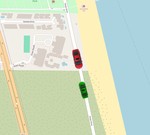Represents a Map Object for BindCanvas. More...
#include <BindMap.hpp>

Public Member Functions | |
| uint16_t | getBytes (uint8_t *out) override |
Get the serialized bytes of the BindMap object. | |
Public Attributes | |
| int16_t | x |
| X-coordinate position of the map. | |
| int16_t | y |
| Y-coordinate position of the map. | |
| uint8_t | cmdId = 0 |
| Command identifier for the map. See the notes for possible cmdId values. | |
| int16_t | width = 100 |
| Width of the map. | |
| int16_t | height = 100 |
| Height of the map. | |
| float | lat = 0.0f |
| Latitude of the map's center. | |
| float | lon = 0.0f |
| Longitude of the map's center. | |
| float | mapOrientation = 0.0f |
| Orientation angle of the map (in degrees). | |
| int8_t | zoom = 1 |
| Zoom level of the map. | |
 Public Attributes inherited from BindView Public Attributes inherited from BindView | |
| int16_t | tag |
Represents a Map Object for BindCanvas.

The BindMap class is used to display and control a street map within the BindCanvas framework. It allows users to show and interact with maps, including changing the map's location, orientation, and zoom level. Users can manually control the map zoom or use predefined zoom levels.
To use a BindMap object, create an instance and configure its properties, including position, dimensions, latitude, longitude, orientation, and zoom level. You can then add it to the BindCanvas for rendering and interaction by calling the sync function.
BIND_MAP_USER_ZOOM constant can be used to let the user manually change the map's zoom level. You can also set predefined zoom levels as needed.
|
inlineoverridevirtual |
Get the serialized bytes of the BindMap object.
This function serializes the BindMap object into a byte array, which can be sent to BindCanvas for rendering and interaction.
| out | Pointer to the output buffer where the serialized data will be stored. |
Reimplemented from BindView.